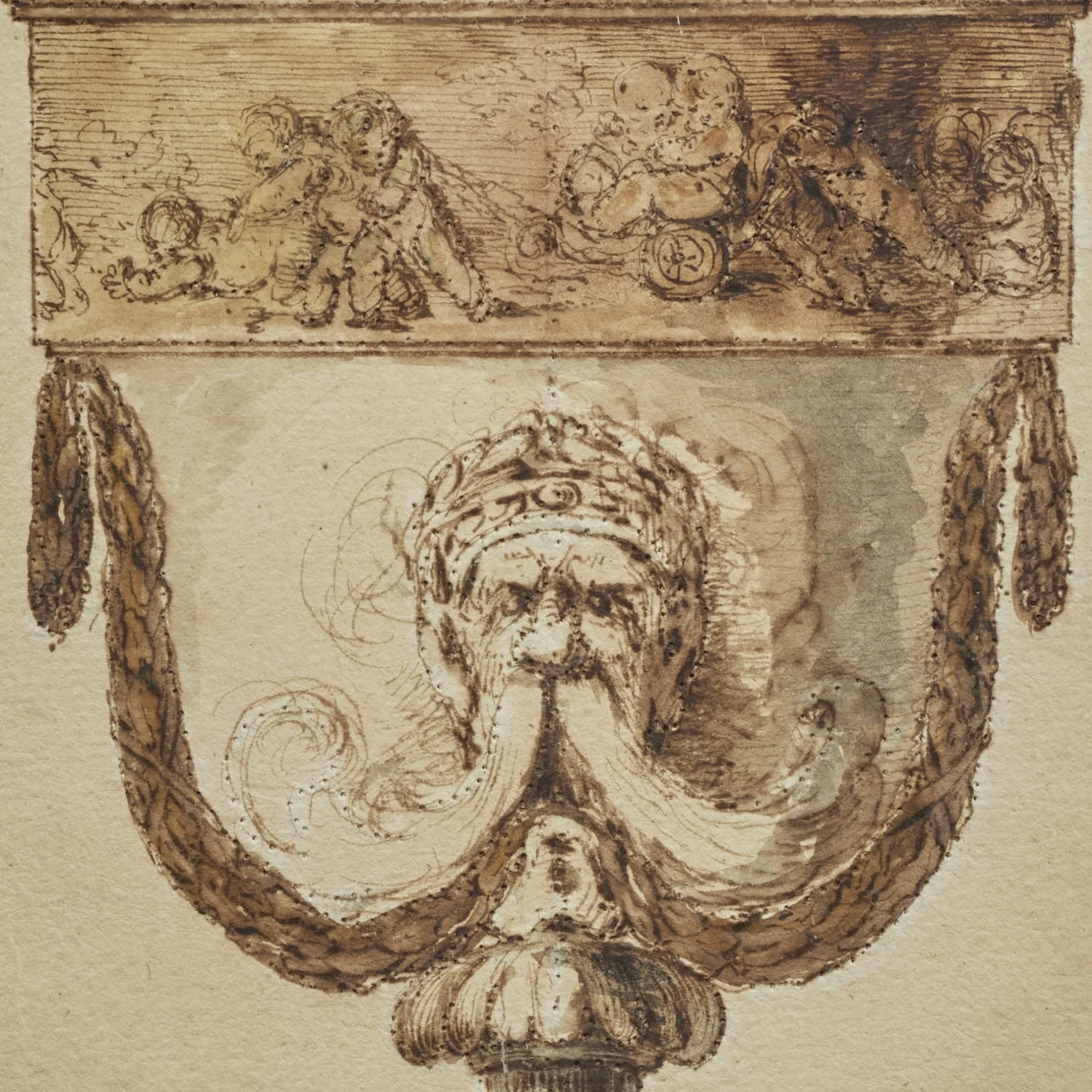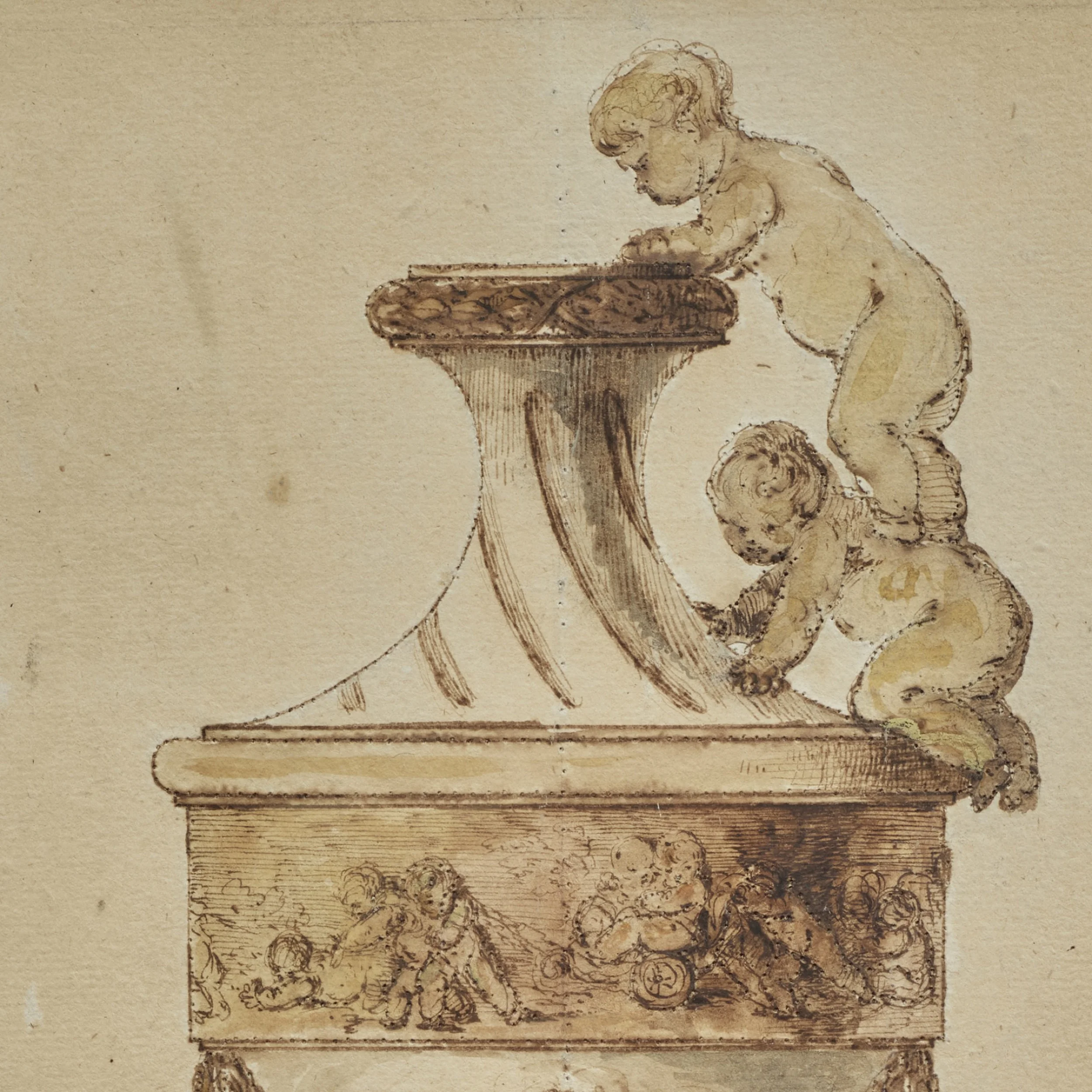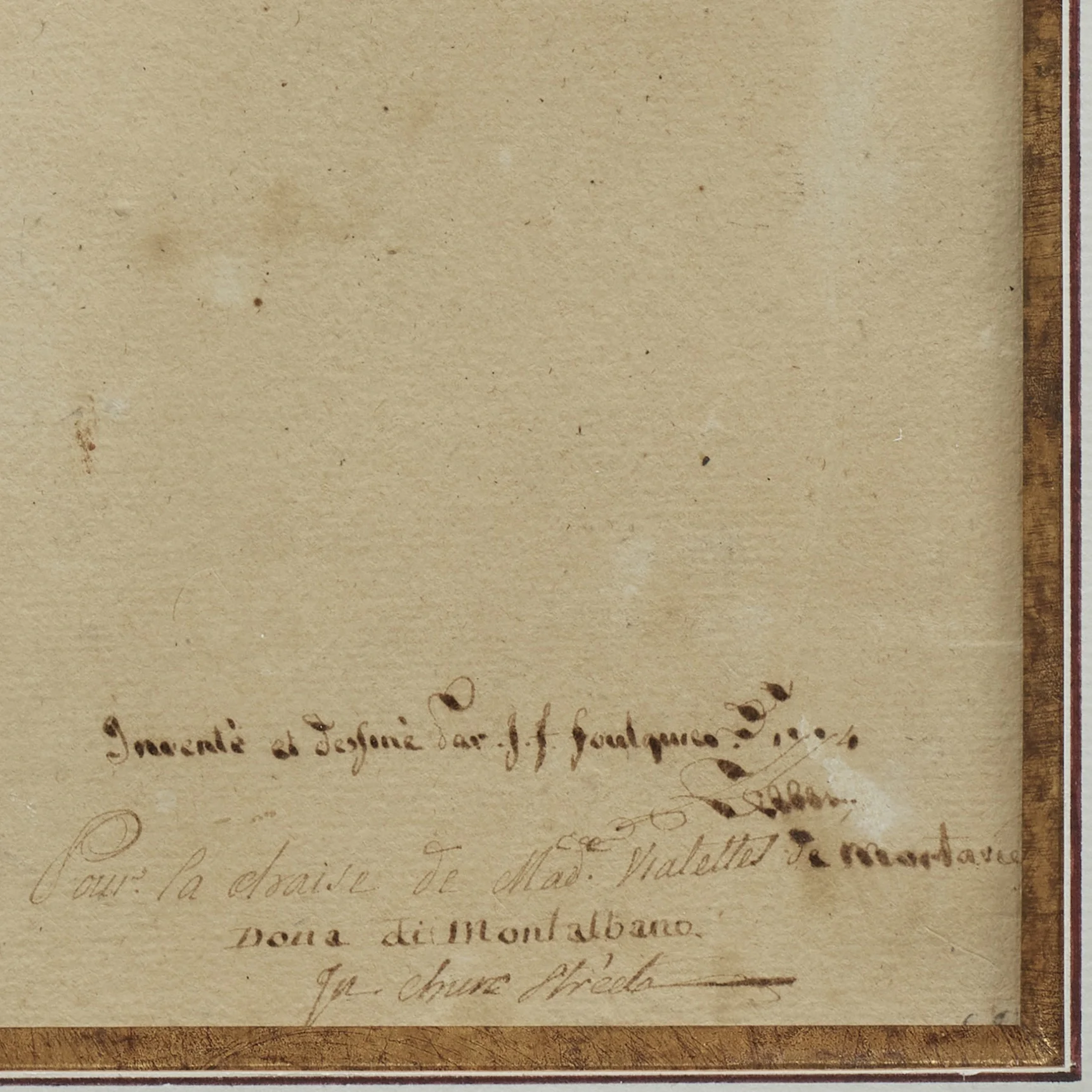Drawing of a neoclassical vase
- Description
- Histoire
France, 1774
Joseph François Foulquier (1744−1789)
Collection stamp: N
Black chalk, pen and brown ink, yellow and blue watercolor, gray wash
Piqué for transfer
With frame:
Height: 37,5 cm – 15 inches
Width: 35 cm – 14 inches
Without frame:
Height: 56 cm – 22 inches
Width: 43 cm – 17 inches
Annotations:
- On the base of the vase: Designed and invented by J. F. Foulquier 1774
- Bottom right: Invented and designed by J.F. Foulquier 1774 / For the chair of Mad.e Vialettes de Mortarieu / Dona di Montalbano / In Churc. Streets
Comparable examples:
- Jean Charles Delafosse, Three vases « à la grecque », 2nd half of the 18th century, pen, black ink, gray wash, paper (cream), Musée des Beaux-Arts de Rouen (inv. AG.1975.4.633)
- Jean-Louis Prieur, Model of a bronze vase, Paris, circa 1780–1790, pen, black ink, sepia watercolor, Paris, Musée des Arts Décoratifs (inv. cd 41)
- Jean-Louis Prieur, Model of a bronze vase, Paris, circa 1780–1790, pen, black ink, sepia watercolor, graphite pencil, Paris, Musée des Arts Décoratifs (inv. 3413)
- Attributed to Claude Michel dit Clodion, Vase, 1762–71, terra cotta, Boston, Museum of Fine Art (inv. 1989.48)
This model of vase is represented according to the vertical median axis of the sheet. Made with a pen and black ink, it is enhanced with yellow watercolor on a gray wash background. This ewer-shaped vase with a base decorated with foliage rests on a fluted pedestal which border is decorated with a border of foliage. The protruding part of the ewer is decorated with a central escutcheon in projection formed of a satyr's head crowned with foliage, whose moustache continues in important volutes on both sides. These volutes follow the shape of two laurel garlands hanging on each side of the vase. The upper part of the body of the ewer presents a frieze on which is drawn a scene of children playing. The neck is provided with twisted flutes and ends with a ringed neckline with a foliage motif. The handle consists of two children, one of whom seems to be looking at the inside of the ewer and is mounted on the back of a second child on all fours.
This vase rests on a console which central part in hollow presents a profile of woman in an oval medallion circled with laurel garlands suspended by a knot. A button of foliage underlines the lower part of the console. This last one, as well as the laurel garlands on the pedestal and the neck, suspended on the central part or framing the medallion as well as the frieze are enhanced with yellow watercolor. The knot of the medallion is highlighted with blue watercolor. The outline of the whole is punctuated with small, pierced point used for the transfer.
Ornamental drawings
First step of an emerging idea, design drawings can be requested by patrons, collectors, or clients, the merciers or architects from an architect, a decorator, an ornamentalist, a sculptor, or even a painter. Most often anonymous, the drawings of ornaments sometimes reveal the hand of a known artist - cabinetmaker, silversmith, sculptor or painter - or can be linked to his workshop. The architect and ornamentalist Gilles-Marie-Oppenord (1672-1742), the architects Gabriel for Louis xv, Ledoux for Madame du Barry in Louveciennes, Mique for Madame du Barry in Bellevue thus proposed drawings for the light fixture or the fireplace as well as for the woodwork.
An essential figure of creation in the field of decorative arts, ornamentalists are artists who invent, design and execute ornaments covering all possible categories, from architectural decoration to the embellishment of a décor or an object. They are not owners of their creations which can be reproduced in all kinds of materials by the craftsmen. Contemporary of Foulquier, Jean-Charles Delafosse (1734-1791), architect and ornamentalist was one of the important representatives of that profession. Jean-Louis Prieur, around 1770, was one of the first professional designers. He made drawings of models for bronze so that they could be registered and protected. At the same time, architects such as Charles de Wailly, or artists such as François Boucher were still making proposals. In this respect, the collaboration of the latter with the Sèvres factory is a meaningful illustration.
It is therefore not surprising to find the name of an artist better known for his works mixing satire and grotesque, illustrated here in this type of proposal. Manifestation of an idea in the making, the drawing becomes a real tool of creation. Sometimes simple sketches, others, like the one studied here are much more finished, constituting the projection of the object ready to be realized or an ideal representation intended to incite a patron to order a work of art. If these drawings have above all a practical function: to be a key element of the conception of the objects, their manufacture or their marketing, most of them are true works of art, because of their aesthetic qualities and their sometimes-virtuoso execution. Thus, they were quickly collected by amateurs as well as by artists who drew inspiration from them. The presence here of traces of piqué indicates that this drawing was a step in the process of creating a sculpture, a bronze, a painting, or another material. Moreover, the fact that this drawing is signed and dated twice and that it also specifies its original purpose "Pour la chaise de Mad.e Vialettes de Mortarieu", probably designating a chair cabinet, indicates that it was immediately appreciated as a work of art in its own right.
The collector's mark N, in the lower right corner of the console confirms that it also belonged to a collection important enough to have its own mark. It could be associated with the Nathan Collection (an English collection of the 20th century).
The vases “à l'antique”
At the end of the 18th century, it was fashionable to represent ancient vases, following the discovery of the interior decoration of the Roman palaces of the Palatine and the excavations of Hadrian's villa in Tivoli, where such objects could be found. Many artists were interested in this theme and made proposals, such as Jean-Louis Prieur (1732-1795), who published several collections of engravings of vases between 1783 and 1792. One can find in his drawings proposals exploiting the figure of a child whose attitude follows or forms the handle, or the theme of children's games, ideas also used here by Foulquier and present in the works of artists like Delafosse or Clodion.
Joseph François Foulquier (1744-1789)
Painter, engraver and art collector, Joseph-François Foulquier was born in Toulouse on February 21, 1745, into a well-off family belonging to the local nobility, his father, Louis Foulquier, being a merchant and capitoul. Having received a careful education at the college of Sorèze in the literary and scientific fields, he studied law, thus fulfilling his parents’ wishes. He entered the parliament of Toulouse as a counsellor and arrived in Paris where he met the Alsatian painter Philippe-Jacques de Loutherbourg, who taught him the art of drawing and engraving. Between 1765 and 1773, he engraved a number of plates, either after masters such as Jean-Baptiste Despax, or of his own invention, in a mixture of fantasy, satire and grotesque. He participated in the organization of the Salon exhibition in 1774/ 1775. In 1981, he became the intendant of Guadeloupe and moved there. He was in contact with Jean-Jacques Rousseau, with whom he corresponded. During the first years of his stay, he brought astronomers, physicists, draughtsman and painters, and periodically sent reports to Paris and plant samples to the king's gardens. He also sent some to the botanical garden of Toulouse.
In 1786, he was transferred as intendant of Martinique where he died on February 13, 1789.
Vialettes de Mortarieu family
The Vialettes family, originally from Rouergue, settled in the region of Montauban around the 15th century. Having embraced the reformation, it joined a place of safety where several of its members appear in the first charges of the Public Administration, among which the baron Vialètes de Mortarieu, name of a property located at a few kilometers from Montauban, is particularly famous. At the end of the 18th century, they owned a beautiful villa on the site of the current rose garden of Montauban. The most famous member of the family is Joseph Vialetes de Mortarieu, who was born in 1768. Appointed Mayor, he contributed to the modernization of the city and built a private mansion that can still be seen today. Officer of the Legion of Honor and Baron of the Empire, he pleaded the cause of his city to Napoleon in 1808 who, following a visit that he was able to motivate, allowed Montauban to become the capital of the new department of Tarn-et-Garonne. The fall of the Empire did not interrupt his ascent since in 1819 he was named Prefect of the Ariège.
We do not know the links between Mademoiselle Vialette de Mortarieu and this one, but they were probably quite close, brothers or cousins. In the state of our knowledge, we cannot specify where her cabinet de chaise was. It is established that in the last years of the 18th century, there was a beautiful villa on the site of the present rose garden of Montauban where it could have been located.
Bibliography
- Pierre Verlet, Les Bronzes Dorés Français du xviiie Siècle, Paris, Éditions Picard, 1987.
- Etienne-Léon de Lamothe-Langon, Biographie toulousaine : ou Dictionnaire historique de personnages…se sont rendus célèbres dans la ville de Toulouse, ou qui ont contribué à son illustration, Tome 1, Paris, 1823, p. 247.
- Annuaire du Tarn et Garonne, 1851.
- Collective catalog, Clodion (1738 – 1814), Paris, Éditions de la Réunion des Musées Nationaux, 1992.
- Collective catalog, Dessiner et ciseler le bronze. Jean-Louis Prieur (1732−1795), musée Nissim de Camondo, Paris, 2015.




